Caught in a Deadlock: Small Ruminant Farming on the Greek Island of Samothrace. The Importance of Regional Contexts for Effective EU Agricultural Policies
Abstract
1. Introduction
2. Material and Methods
2.1. The Island Samothrace
2.2. The Conceptual Framework
2.3. Biophysical Assessment of the Livestock System
- For the assessment of feed intake of sheep and goats on Samothrace, we set up the herd and feed rations modules of GLEAM (Global Livestock Environmental Assessment Model) in Excel (For a detailed description of GLEAM, its components and equations, refer to http://www.fao.org/gleam/en/. For a detailed description of equations used for the present study see Supplementary Information: Section 4 and Supplementary Data: Tables S1–S4.) [31]. For the description of this model in Section 2.3.1, we follow the ODD (Overview, Design Concepts, Details) protocol that has been widely used to describe simulation models in multiple disciplines [32,33].
- For the estimation of the grazing capacity of the island’s ecosystems (Section 2.3.2), we used net primary production (NPP) data derived from Fetzel et al. [24], and the Normalized Difference Vegetation Index (NDVI) derived from Löw [27].
2.3.1. Calculation of Metabolic Requirements of Small Ruminants Based on GLEAM
2.3.2. Estimation of the Grazing Capacity of Local Ecosystems
2.4. Social and Monetary Assessment of the Local Small Ruminant Farming System
2.5. Validation and Uncertainty of the Utilized Model and Data
3. Results
3.1. Development of the Total Livestock Units on Samothrace 1929–2016
3.2. The Metabolism of the Small Ruminant Population of Samothrace 1993–2016
3.3. Utilization of Grazing Resources by the Small Ruminant Population
3.4. The (Under-)Utilization of Production Potentials
3.5. The Monetary Economy of the Small Ruminant Farming System in 2016
4. Discussion
4.1. The Sustainability Crisis of the Small Ruminant Farming System on Samothrace
4.2. The Regression of Sedentary Extensive Small Ruminant Farming Systems
4.3. The European Common Agricultural Policy (CAP) as a Socio-Economic Driver for Changes Affecting the Small Ruminant Farming System on Samothrace
4.4. The Future of Small Ruminant Farming in the Mediterranean
5. Conclusions
Supplementary Materials
Author Contributions
Funding
Acknowledgments
Conflicts of Interest
References
- Steinfeld, H.; Gerber, P.; Wassenaar, T.D.; Castel, V.; Rosales, M.; Rosales, M.; de Haan, C. Livestock’s Long Shadow: Environmental Issues and Options; Food & Agriculture Org.: Roma, Italy, 2006; ISBN 978-92-5-105571-7. [Google Scholar]
- Herrero, M.; Wirsenius, S.; Henderson, B.; Rigolot, C.; Thornton, P.; Havlík, P.; de Boer, I.; Gerber, P.J. Livestock and the Environment: What Have We Learned in the Past Decade? Annu. Rev. Environ. Resour. 2015, 40, 177–202. [Google Scholar] [CrossRef]
- Kizos, T.; Plieninger, T.; Schaich, H. “Instead of 40 Sheep there are 400”: Traditional Grazing Practices and Landscape Change in Western Lesvos, Greece. Landsc. Res. 2013, 38, 476–498. [Google Scholar] [CrossRef]
- Rigueiro-Rodríguez, A.; Fernández-Núñez, E.; González-Hernández, P.; McAdam, J.H.; Mosquera-Losada, M.R. Agroforestry Systems in Europe: Productive, Ecological and Social Perspectives. In Agroforestry in Europe: Current Status and Future Prospects; Rigueiro-Rodróguez, A., McAdam, J., Mosquera-Losada, M.R., Eds.; Advances in Agroforestry; Springer: Dordrecht, The Netherlands, 2009; pp. 43–65. ISBN 978-1-4020-8272-6. [Google Scholar]
- EEA. High Nature Value (HNV) Farmland. Available online: https://www.eea.europa.eu/data-and-maps/data/high-nature-value-farmland (accessed on 13 December 2019).
- Bernués, A.; Ruiz, R.; Olaizola, A.; Villalba, D.; Casasús, I. Sustainability of pasture-based livestock farming systems in the European Mediterranean context: Synergies and trade-offs. Livest. Sci. 2011, 139, 44–57. [Google Scholar] [CrossRef]
- Caroprese, M. Sustainability of Sheep and Goat Production Systems. In The Sustainability of Agro-Food and Natural Resource; Springer: Berlin, Germany, 2015. [Google Scholar]
- Hadjigeorgiou, I. Sheep and goat farming and rural development in Greece. In Proceedings of the International Conference Celebrating Pastoral Life Heritage and Economic Development, Athens, Greece, 11–12 September 2014. [Google Scholar]
- De Rancourt, M.; Fois, N.; Lavín, M.P.; Tchakérian, E.; Vallerand, F. Mediterranean sheep and goats production: An uncertain future. Small Rumin. Res. 2006, 62, 167–179. [Google Scholar] [CrossRef]
- Hadjigeorgiou, I. Past, present and future of pastoralism in Greece. Pastor. Res. Policy Pract. 2011, 1, 24. [Google Scholar] [CrossRef]
- Álvarez-Martínez, J.; Gómez-Villar, A.; Lasanta, T. The Use of Goats Grazing to Restore Pastures Invaded by Shrubs and Avoid Desertification: A Preliminary Case Study in the Spanish Cantabrian Mountains. Land Degrad. Dev. 2016, 27, 3–13. [Google Scholar] [CrossRef]
- Pinto-Correia, T.; Guiomar, N.; Ferraz-de-Oliveira, M.I.; Sales-Baptista, E.; Rabaça, J.; Godinho, C.; Ribeiro, N.; Sá Sousa, P.; Santos, P.; Santos-Silva, C.; et al. Progress in Identifying High Nature Value Montados: Impacts of Grazing on Hardwood Rangeland Biodiversity. Rangel. Ecol. Manag. 2018, 71, 612–625. [Google Scholar] [CrossRef]
- Pe’er, G.; Bonn, A.; Bruelheide, H.; Dieker, P.; Eisenhauer, N.; Feindt, P.H.; Hagedorn8, G.; Hansjürgens, B.; Herzon, I.; Lomba, A.; et al. Action Needed for the EU Common Agricultural Policy to Address Sustainability Challenges. 2019. Available online: https://www.idiv.de/fileadmin/content/Files_CAP_Fitness_Check/Peer_et_al__CAP_scientists_statement_online_01.pdf (accessed on 20 January 2020).
- Fischer-Kowalski, M.; Xenidis, L.; Singh, S.J.; Pallua, I. Transforming the Greek Island of Samothraki into a UNESCO Biosphere Reserve. An Experience in Transdisciplinarity. GAIA-Ecol. Perspect. Sci. Soc. 2011, 20, 181–190. [Google Scholar] [CrossRef]
- Biel, B.; Tan, K. Flora of Samothraki; Goulandris Natural History Museum: Athens, Greece, 2014; ISBN 978-960-464-585-5. [Google Scholar]
- Panagopoulos, Y.; Dimitriou, E.; Skoulikidis, N. Vulnerability of a Northeast Mediterranean Island to Soil Loss. Can Grazing Management Mitigate Erosion? Water 2019, 11, 1491. [Google Scholar] [CrossRef]
- Psyllos, G.; Kizos, T.; Hadjigeorgiou, I.; Dimitrakopoulos, P.G. Grazing land management and sheep farm viability in semi—Arid areas: Evidence from Western Lesvos, Greece. In Options Méditerranéennes. Series A: Mediterranean Seminars; CIHEAM-IAMZ: Zaragoza, Spain; Democritus University of Thrace: Xanthi, Greece; Arisstotle University of Thessalniki: Thessalniki, Greece; Hellenic Range and Pasture Society: Thessaloniki, Greece, 2016. [Google Scholar]
- Haberl, H.; Fischer-Kowalski, M.; Krausmann, F.; Weisz, H.; Winiwarter, V. Progress towards sustainability? What the conceptual framework of material and energy flow accounting (MEFA) can offer. Land Use Policy 2004, 21, 199–213. [Google Scholar] [CrossRef]
- Haberl, H.; Wiedenhofer, D.; Pauliuk, S.; Krausmann, F.; Müller, D.B.; Fischer-Kowalski, M. Contributions of sociometabolic research to sustainability science. Nat. Sustain. 2019, 2, 173. [Google Scholar] [CrossRef]
- Kelle, U. Die Integration qualitativer und quantitativer Forschung—Theoretische Grundlagen von, “Mixed Methods”. KZfSS Köln. Z. FürSoziol. Soz. 2017, 69, 39–61. [Google Scholar] [CrossRef]
- De Molina, M.G.; Fernández, D.S.; Casado, G.G.; Infante-Amate, J.; Fernández, E.A.; Traver, J.V.; Ruiz, R.G. The Social Metabolism of Spanish Agriculture, 1900–2008; The Mediterranean Way Towards Industrialization; Environmental History; Springer International Publishing: Cham, Germany, 2020; ISBN 978-3-030-20899-8. [Google Scholar]
- Petridis, P. Perceptions, attitudes and involvement of local residents in the establishment of a Samothraki Biosphere Reserve, Greece. J. Prot. Mt. Areas Res. Manag. 2012, 4, 59–63. [Google Scholar] [CrossRef][Green Version]
- ELSTAT Population Census. Available online: https://www.statistics.gr/en/home/ (accessed on 13 December 2019).
- Fetzel, T.; Petridis, P.; Noll, D.; Singh, S.J.; Fischer-Kowalski, M. Reaching a socio-ecological tipping point: Overgrazing on the Greek island of Samothraki and the role of European agricultural policies. Land Use Policy 2018, 76, 21–28. [Google Scholar] [CrossRef]
- Petridis, P.; Singh, S.J.; Fischer-Kowalski, M.; Noll, D. The role of science in sustainability transitions: Citizen science, transformative research, and experiences from Samothraki island, Greece. Isl. Stud. J. 2017, 115–134. [Google Scholar] [CrossRef]
- Fischer-Kowalski, M.; Löw, M.; Noll, D.; Petridis, P.; Skoulikidis, N. Samothraki in Transition: A Report on a Real World Lab to Promote the Sustainability of a Greek Island. Sustainability. Under Review.
- Löw, M. Spatial Patterns of Land Cover Dynamics on Samothraki Island. Master’s Thesis, Alpen Adria University, Vienna, Austria, 2016. [Google Scholar]
- Laner, D.; Rechberger, H.; Astrup, T. Systematic Evaluation of Uncertainty in Material Flow Analysis. J. Ind. Ecol. 2014, 18, 859–870. [Google Scholar] [CrossRef]
- ELSTAT Annual Agricultural Statistical Survey. Available online: https://www.statistics.gr/en/home/ (accessed on 13 December 2019).
- Krausmann, F.; Erb, K.-H.; Gingrich, S.; Lauk, C.; Haberl, H. Global patterns of socioeconomic biomass flows in the year 2000: A comprehensive assessment of supply, consumption and constraints. Ecol. Econ. 2008, 65, 471–487. [Google Scholar] [CrossRef]
- FAO Global Livestock Environmental Assessment Model (GLEAM). Food and Agriculture Organization of the United Nations. Available online: http://www.fao.org/gleam/en/ (accessed on 13 December 2019).
- Grimm, V.; Berger, U.; Bastiansen, F.; Eliassen, S.; Ginot, V.; Giske, J.; Goss-Custard, J.; Grand, T.; Heinz, S.K.; Huse, G.; et al. A standard protocol for describing individual-based and agent-based models. Ecol. Model. 2006, 198, 115–126. [Google Scholar] [CrossRef]
- Müller, E.; Hilty, L.M.; Widmer, R.; Schluep, M.; Faulstich, M. Modeling Metal Stocks and Flows: A Review of Dynamic Material Flow Analysis Methods. Environ. Sci. Technol. 2014, 48, 2102–2113. [Google Scholar] [CrossRef]
- Krausmann, F. From Energy Source to Sink: Transformations of Austrian Agriculture. In Social Ecology: Society-Nature Relations across Time and Space; Haberl, H., Fischer-Kowalski, M., Krausmann, F., Winiwarter, V., Eds.; Human-Environment Interactions; Springer International Publishing: Cham, Germany, 2016; pp. 433–445. ISBN 978-3-319-33326-7. [Google Scholar]
- NTSG MODIS GPP/NPP Project (MOD17). Numerical Terradynamic Simulation Group. Available online: http://www.ntsg.umt.edu/project/default.php (accessed on 13 December 2019).
- Jia, W.; Liu, M.; Yang, Y.; He, H.; Zhu, X.; Yang, F.; Yin, C.; Xiang, W. Estimation and uncertainty analyses of grassland biomass in Northern China: Comparison of multiple remote sensing data sources and modeling approaches. Ecol. Indic. 2016, 60, 1031–1040. [Google Scholar] [CrossRef]
- Heiling, C. On the State of Oak Forests in Samothraki: Tree Regeneration, Restoration Priorities and Forest Structure as a Mirror of Past Land Use on a Greek Island; University of Natural Resources and Life Sciences (BOKU): Vienna, Austria, 2018. [Google Scholar]
- Noll, D.; Wiedenhofer, D.; Miatto, A.; Singh, S.J. The expansion of the built environment, waste generation and EU recycling targets on Samothraki, Greece: An island’s dilemma. Resour. Conserv. Recycl. 2019, 150, 104405. [Google Scholar] [CrossRef]
- Krausmann, F. Milk, Manure, and Muscle Power. Livestock and the Transformation of Preindustrial Agriculture in Central Europe. Hum. Ecol. 2004, 32, 735–772. [Google Scholar] [CrossRef]
- Jepsen, M.R.; Kuemmerle, T.; Müller, D.; Erb, K.; Verburg, P.H.; Haberl, H.; Vesterager, J.P.; Andrič, M.; Antrop, M.; Austrheim, G.; et al. Transitions in European land-management regimes between 1800 and 2010. Land Use Policy 2015, 49, 53–64. [Google Scholar] [CrossRef]
- Rescia, A.J.; Willaarts, B.A.; Schmitz, M.F.; Aguilera, P.A. Changes in land uses and management in two Nature Reserves in Spain: Evaluating the social-ecological resilience of cultural landscapes. Landsc. Urban Plan. 2010, 98, 26–35. [Google Scholar] [CrossRef]
- Galanopoulos, K.; Abas, Z.; Laga, V.; Hatziminaoglou, I.; Boyazoglu, J. The technical efficiency of transhumance sheep and goat farms and the effect of EU subsidies: Do small farms benefit more than large farms? Small Rumin. Res. 2011, 100, 1–7. [Google Scholar] [CrossRef]
- European Commission. The Common Agricultural Policy at a Glance. Available online: https://ec.europa.eu/info/food-farming-fisheries/key-policies/common-agricultural-policy/cap-glance_en (accessed on 13 December 2019).
- Renwick, A.; Jansson, T.; Verburg, P.H.; Revoredo-Giha, C.; Britz, W.; Gocht, A.; McCracken, D. Policy reform and agricultural land abandonment in the EU. Land Use Policy 2013, 30, 446–457. [Google Scholar] [CrossRef]
- Matthews, A. Two Steps Forward, one Step Back: Coupled Payments in the CAP—CAP Reform 2015. Available online: http://capreform.eu/two-steps-forward-one-step-back-coupled-payments-in-the-cap/ (accessed on 8 January 2020).
- Canali, G. Common agricultural policy reform and its effects on sheep and goat market and rare breeds conservation. Small Rumin. Res. 2006, 62, 207–213. [Google Scholar] [CrossRef]
- Matthews, A. Brakes Removed from Voluntary Coupled Support—CAP Reform 2018. Available online: http://capreform.eu/brakes-removed-from-voluntary-coupled-support/ (accessed on 8 January 2020).
- Ciaian, P.; Kancs, D.A.; Espinosa, M. The Impact of the 2013 CAP Reform on the Decoupled Payments’ Capitalisation into Land Values. J. Agric. Econ. 2018, 69, 306–337. [Google Scholar] [CrossRef]
- Weis, T. The Ecological Hoofprint: The Global Burden of Industrial Livestock; Zed Books: New York, NY, USA, 2013. [Google Scholar]
- European Parliament Report on the Current Situation and Future Prospects for the Sheep and Goat Sectors in the EU. Available online: http://www.europarl.europa.eu/doceo/document/A-8-2018-0064_EN.html (accessed on 13 December 2019).
- Iliopoulos, C.; Valentinov, V. Opportunism in Agricultural Cooperatives in Greece. Outlook Agric. 2012, 41, 15–19. [Google Scholar] [CrossRef]
- Ronchi, B.; Nardone, A. Contribution of organic farming to increase sustainability of Mediterranean small ruminant livestock systems. Livestig. Prod. Sci. 2003, 80, 17–31. [Google Scholar] [CrossRef]
- Fischer-Kowalski, M.; Rotmans, J. Conceptualizing, Observing, and Influencing Social-Ecological Transitions. Ecol. Soc. 2009, 14, 1–18. [Google Scholar] [CrossRef]
- Fuchs, N.A. Sozial-ökologische Effekte der EU-Agrarsubventionen: Fallstudie zur Ökologischen und Ökonomischen Nachhaltigkeit der Schaf- und Ziegenzucht in Griechenland; AV Akademikerverlag: Saarbrücken, Germany, 2015; ISBN 978-3-639-78946-1. [Google Scholar]
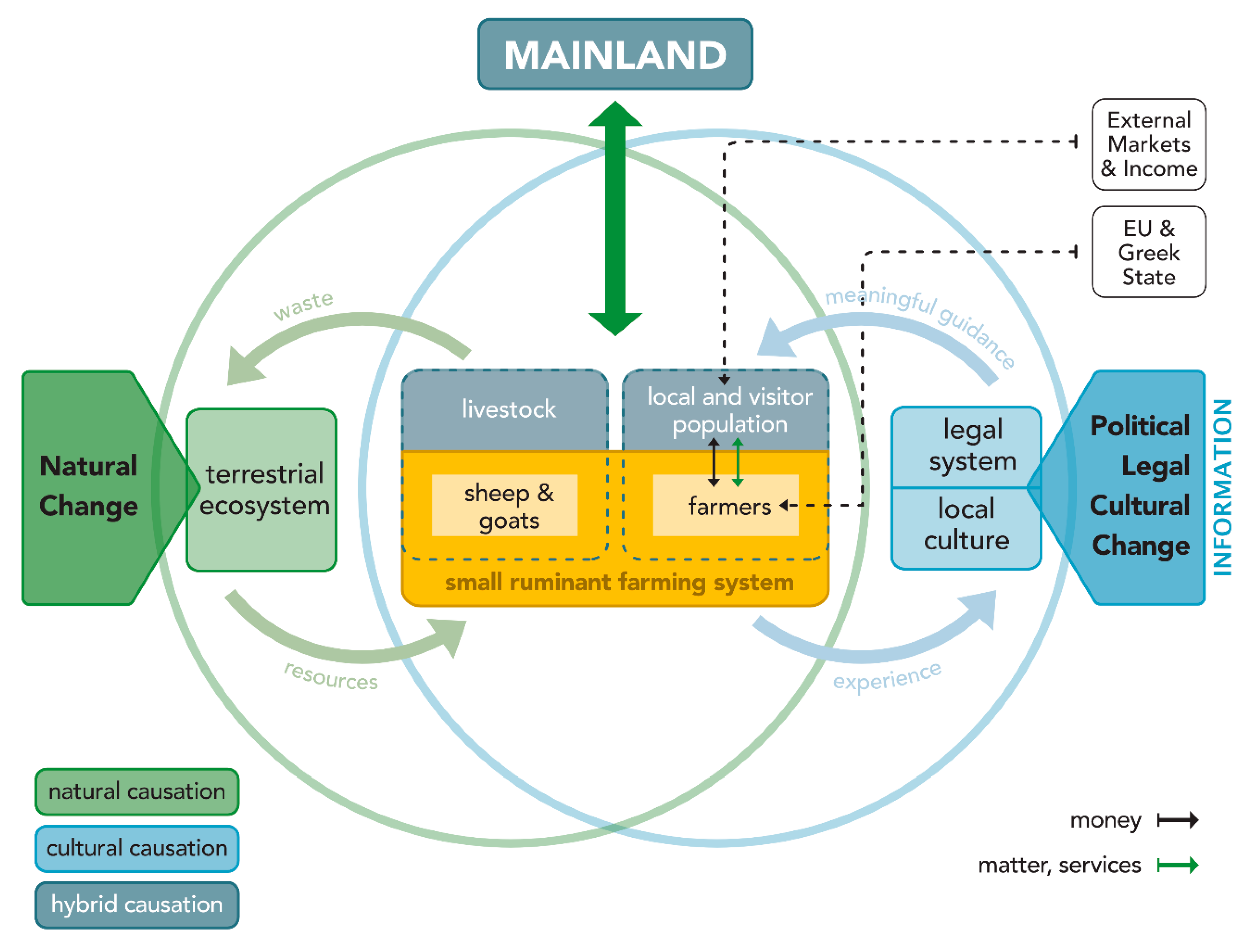


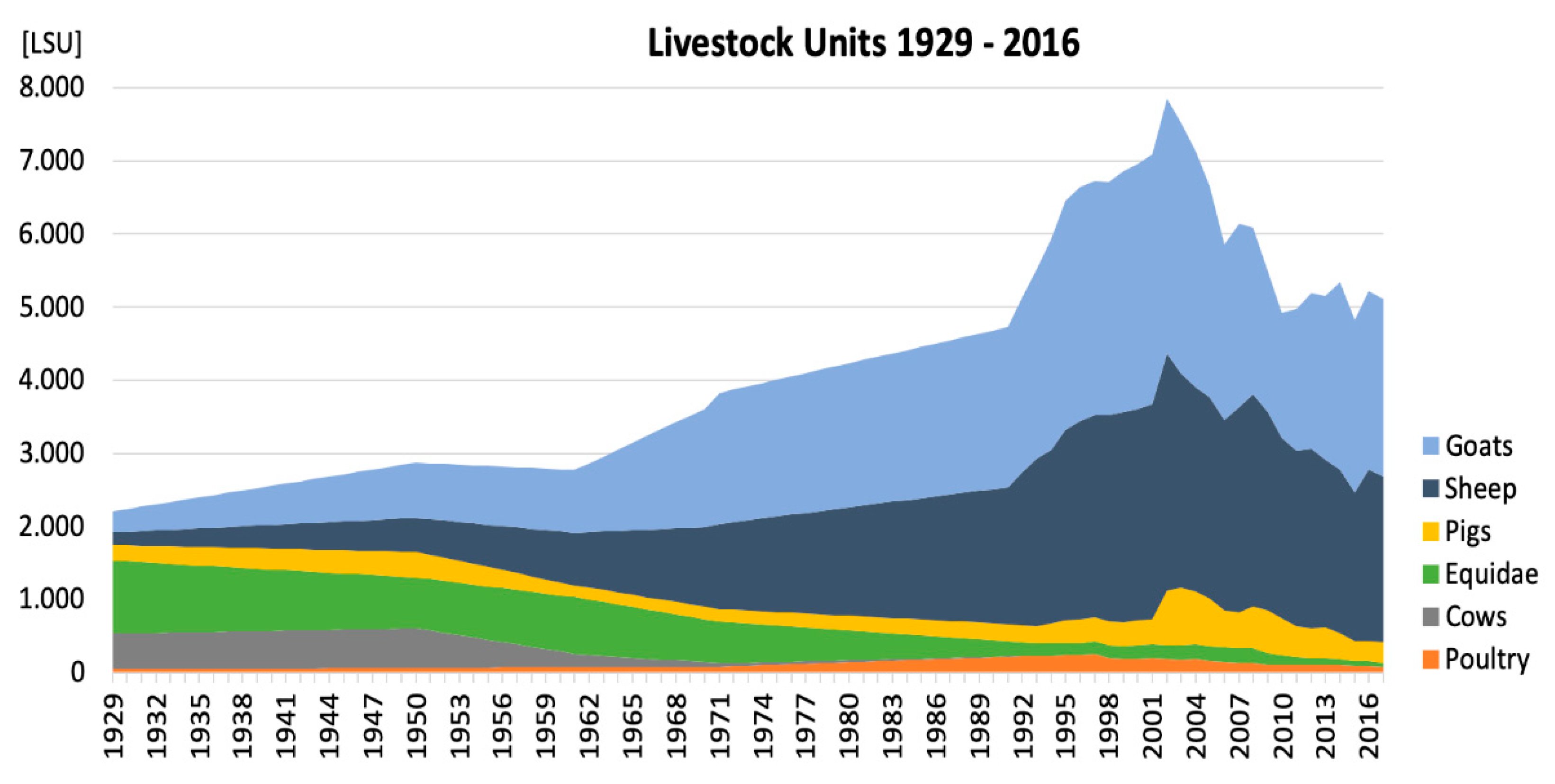
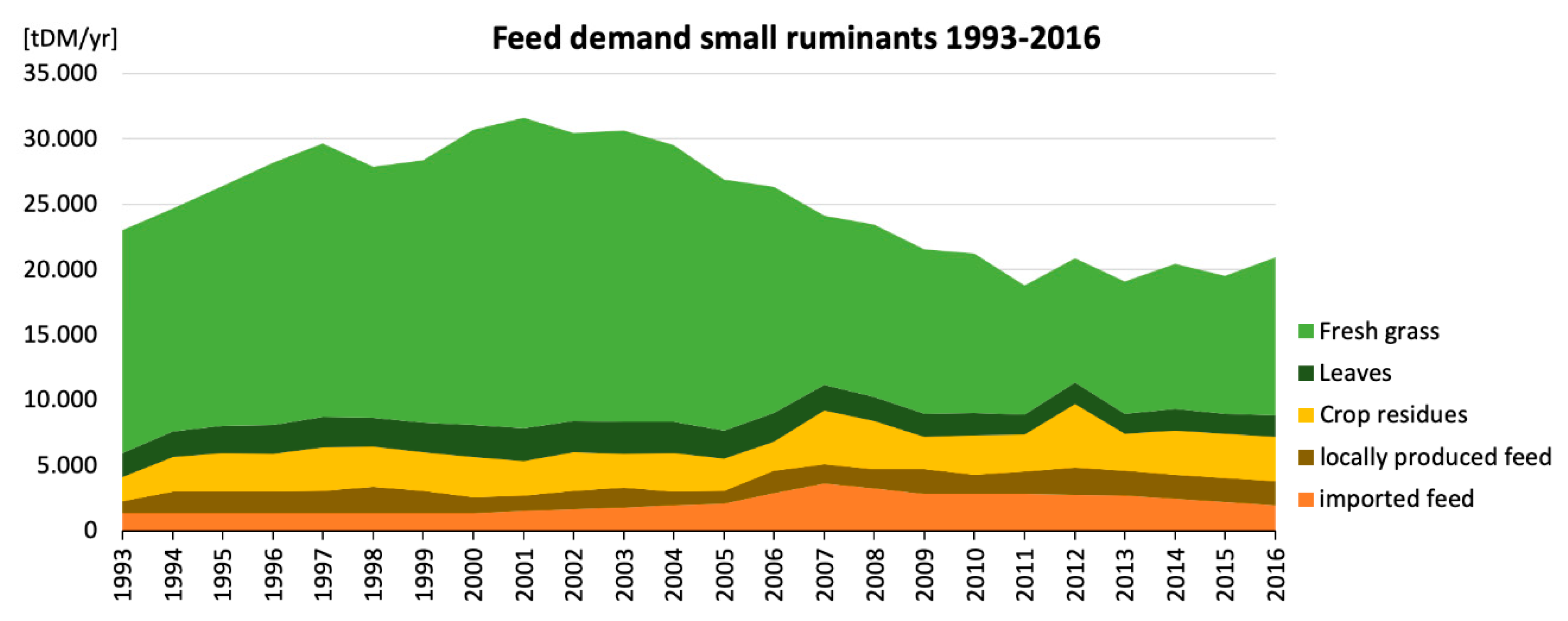
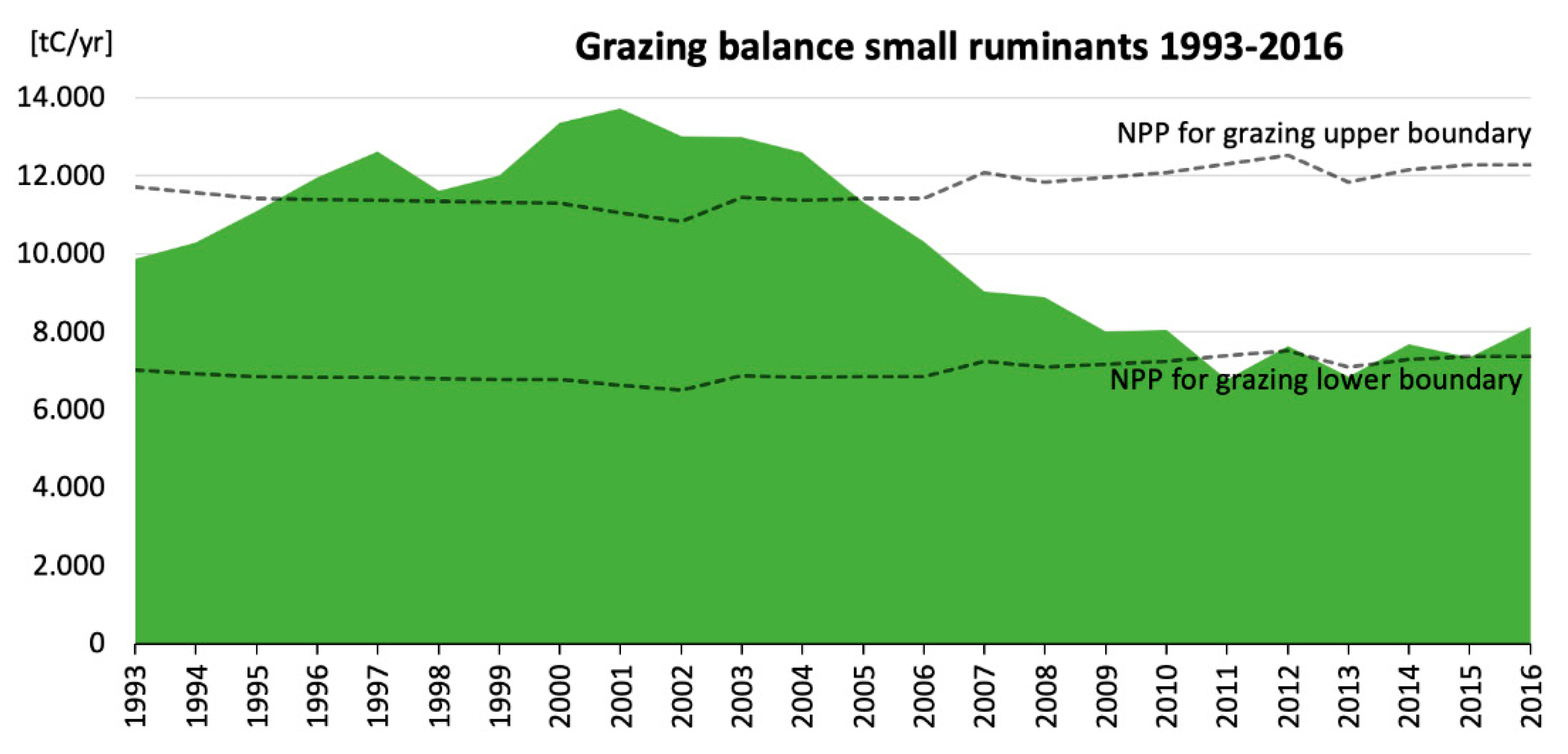
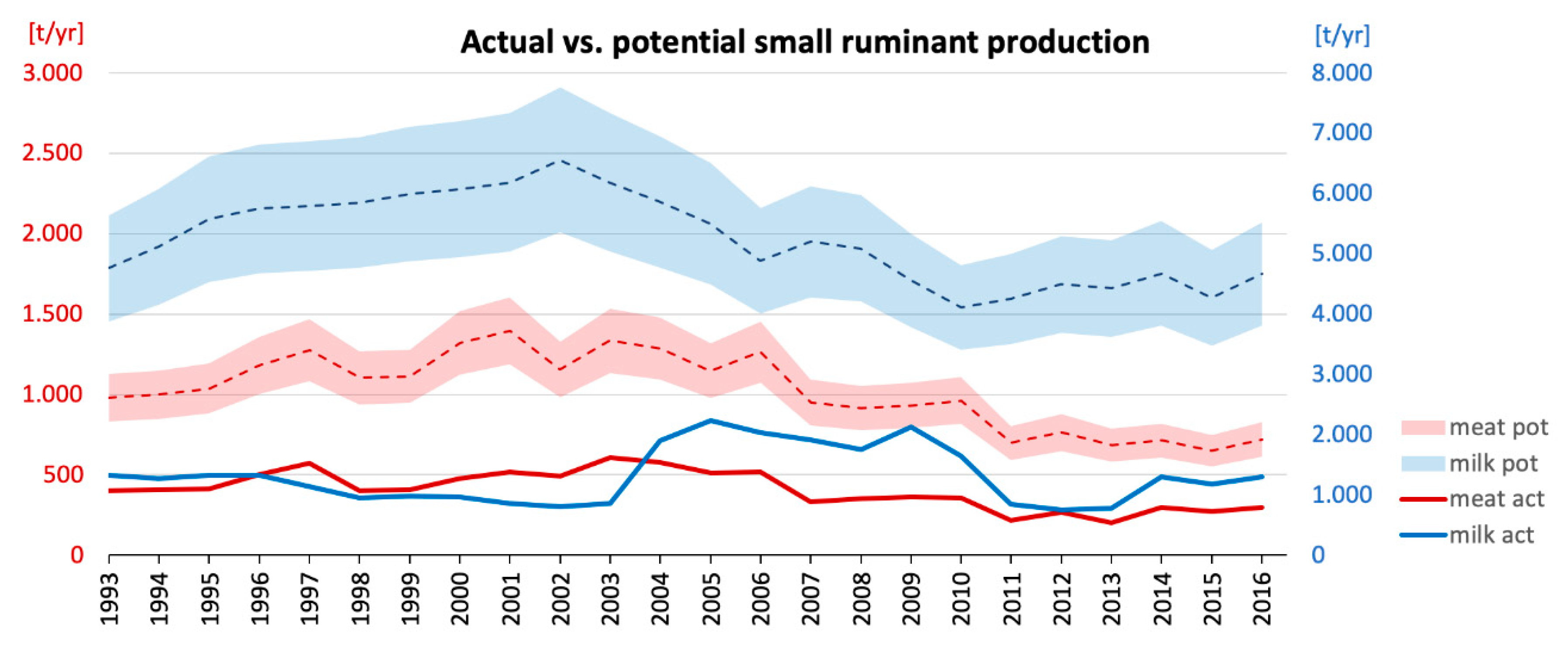
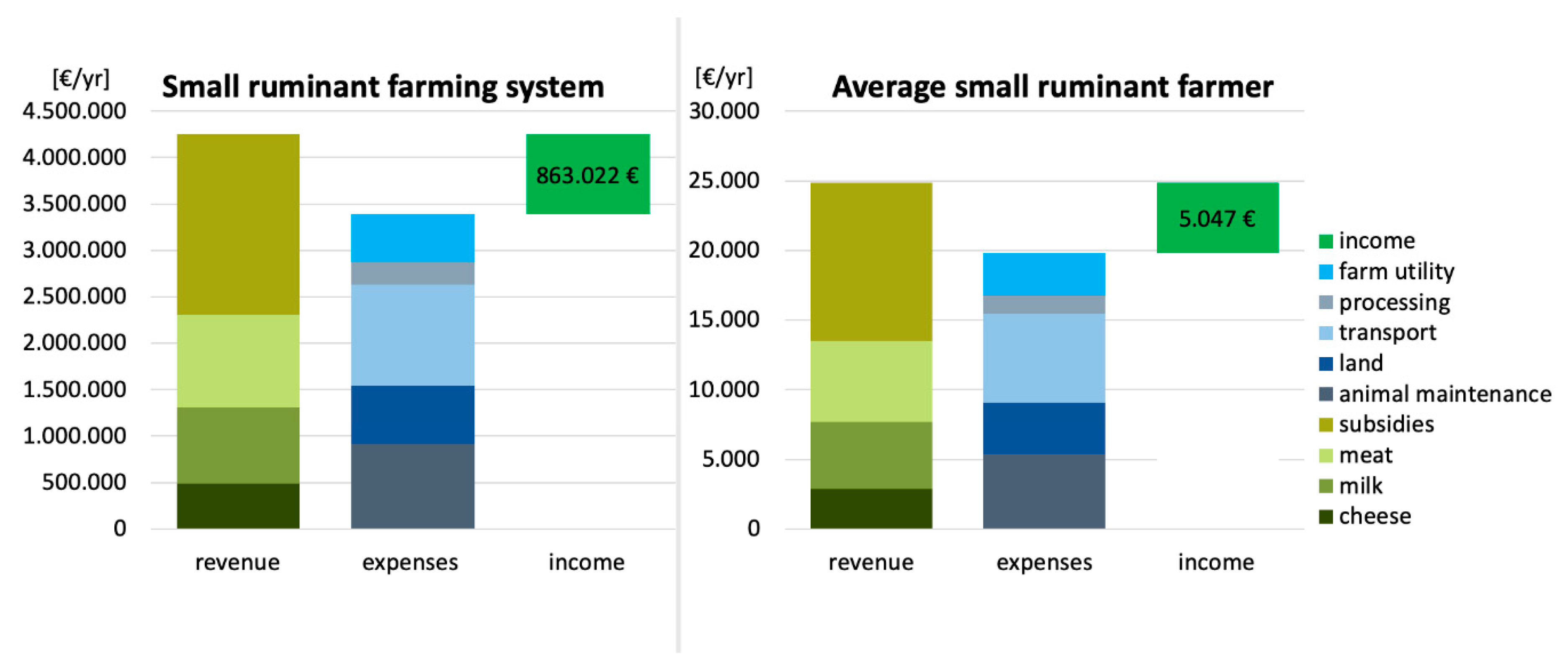
| Overview and Design Concepts of the Utilized Modelling Approach | ||
|---|---|---|
| Overview | purpose | Assess feed requirements of the local SRFS, based on population dynamics and the potential output of livestock products in regard to the availability of feeding resources on the island |
| materials | Grazed biomass and locally produced and imported feed in tons per year | |
| processes | Population dynamics and energy requirements of sheep and goats, translated into biomass consumption | |
| spatial and temporal scale | The island of Samothrace from 1993 to 2016 | |
| system overview | Provided in GLEAM model description (see Supplementary Information: Figure S5) | |
| Design Concepts | basic principles | Retrospective, dynamic and bottom-up or stock driven material flow analysis (MFA) |
| modelling approaches | Dynamic modelling approach based on the Global Livestock Environment Assessment Model (GLEAM) [31] | |
| dissipation | Not explicitly modelled | |
| spatial dimension | A spatially explicit assessment was not conducted | |
| uncertainty | Systematic uncertainty assessment of all model input parameters based on the framework by Laner et al. [28], as well as systematic sensitivity testing | |
© 2020 by the authors. Licensee MDPI, Basel, Switzerland. This article is an open access article distributed under the terms and conditions of the Creative Commons Attribution (CC BY) license (http://creativecommons.org/licenses/by/4.0/).
Share and Cite
Noll, D.; Lauk, C.; Gaube, V.; Wiedenhofer, D. Caught in a Deadlock: Small Ruminant Farming on the Greek Island of Samothrace. The Importance of Regional Contexts for Effective EU Agricultural Policies. Sustainability 2020, 12, 762. https://doi.org/10.3390/su12030762
Noll D, Lauk C, Gaube V, Wiedenhofer D. Caught in a Deadlock: Small Ruminant Farming on the Greek Island of Samothrace. The Importance of Regional Contexts for Effective EU Agricultural Policies. Sustainability. 2020; 12(3):762. https://doi.org/10.3390/su12030762
Chicago/Turabian StyleNoll, Dominik, Christian Lauk, Veronika Gaube, and Dominik Wiedenhofer. 2020. "Caught in a Deadlock: Small Ruminant Farming on the Greek Island of Samothrace. The Importance of Regional Contexts for Effective EU Agricultural Policies" Sustainability 12, no. 3: 762. https://doi.org/10.3390/su12030762
APA StyleNoll, D., Lauk, C., Gaube, V., & Wiedenhofer, D. (2020). Caught in a Deadlock: Small Ruminant Farming on the Greek Island of Samothrace. The Importance of Regional Contexts for Effective EU Agricultural Policies. Sustainability, 12(3), 762. https://doi.org/10.3390/su12030762





